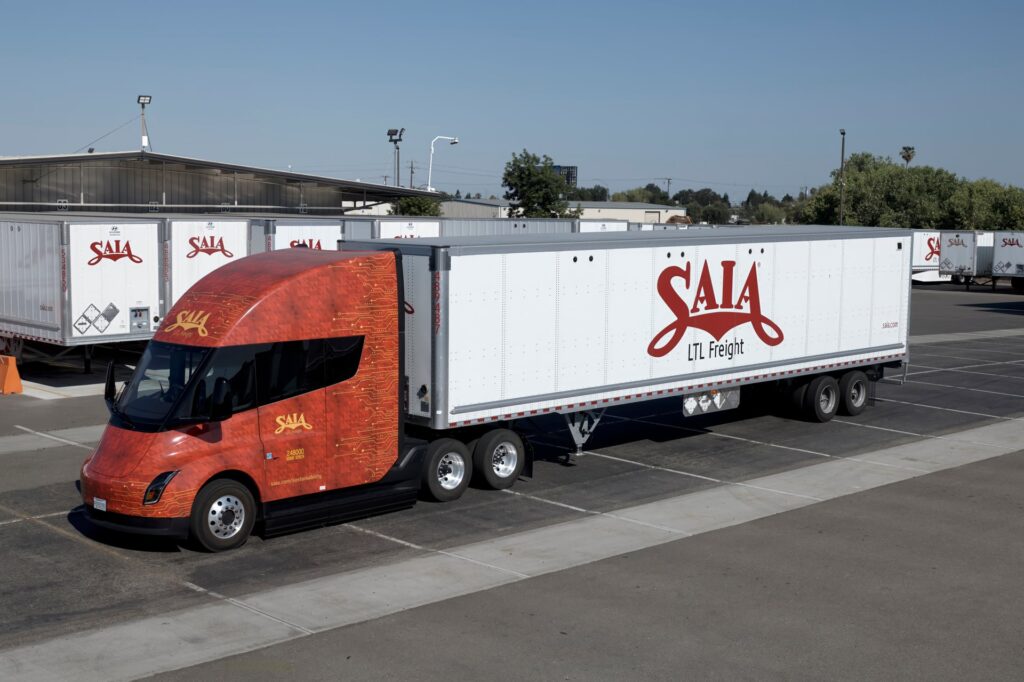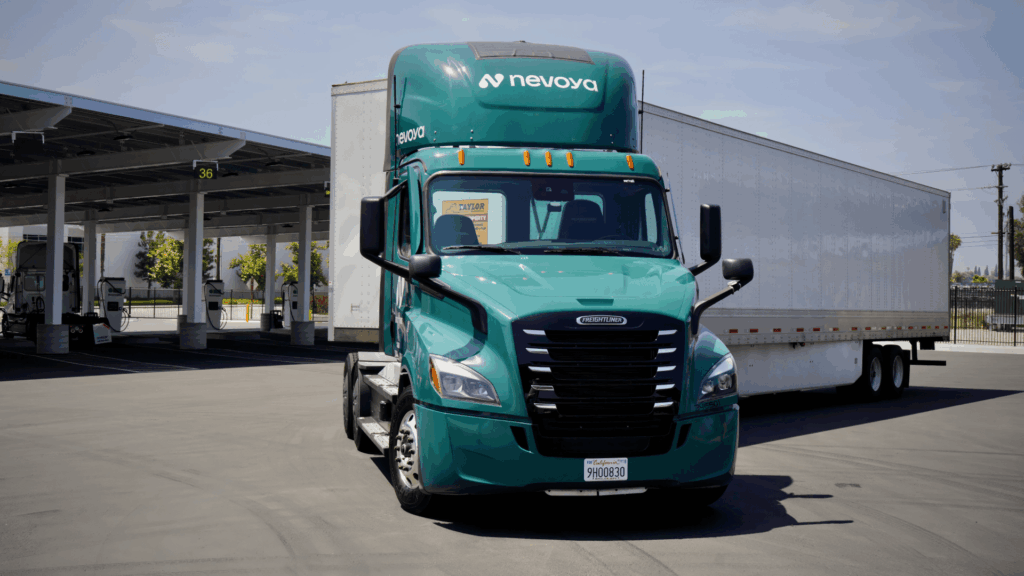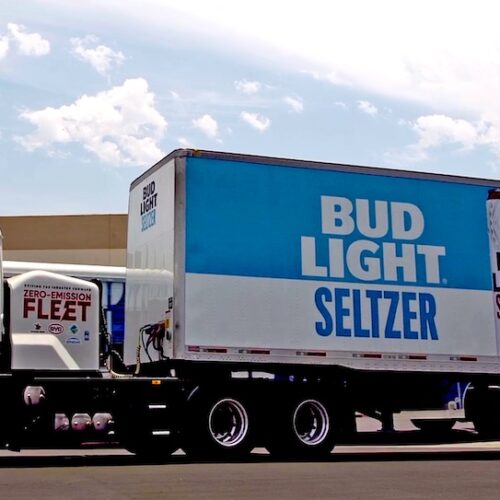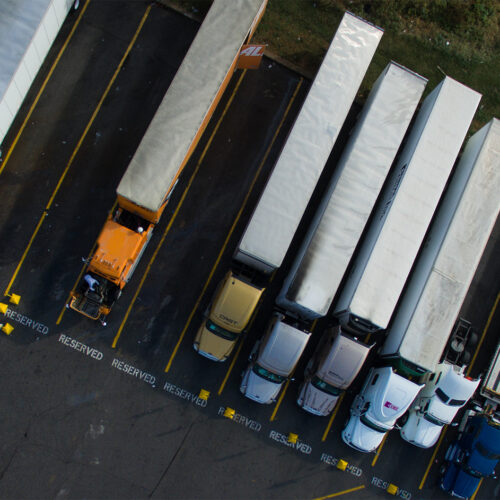Classic American bonnet blue big rig industrial semi truck transporting commercial cargo in refrigerator semi trailer running on mountain road with autumn trees on the sides in Columbia Gorge area
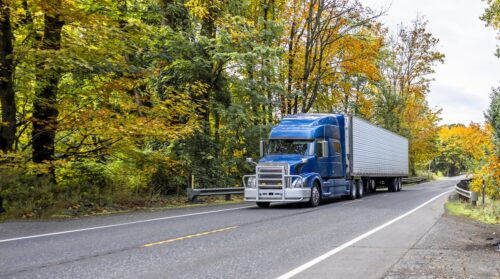
Cleaning Up Long-Haul Trucking
From electric trucks, to hydrogen and renewable diesel, “Run on Less – Messy Middle” demonstrates the trucking industry’s commitment to prove out more efficient, cleaner technologies.
For more than 80 years, diesel has been a reliable, capable fuel for moving practically all of America’s goods. For most of that time, efficiency — how much diesel we used to move that freight — has been important to shippers and carriers, but costs didn’t pose an urgent challenge. Starting around 2000, fuel prices — and priorities — began to shift as diesel went from $1 per gallon to $2, $3 $4, and even $5 in 2008. Although it has since settled back — running around $3.50 per gallon over the past decade — the volatility and higher costs have energized efforts to further improve the efficiency of how America hauls freight.
In recent years, those efforts led some fleets to focus on saving fuel costs by improving their efficiency. As a result, some fleets have surpassed the nation’s long-standing fleet average of 6 miles per gallon (mpg); some now exceed 9 mpg, or are even approaching 10 mpg. With so many fleets chasing higher efficiency for so long, the average fuel economy for the US fleet has crept up to nearly 7 mpg. These improvements have avoided the combustion of some 40 billion gallons of fuel in the process.
More efficient diesel rigs are just part of the story, though. Other solutions have emerged, many related to the source of energy used to propel trucks and move the goods. The industry is exploring a growing mix of alternatives, including bio- and renewable diesel, compressed and renewable natural gas, battery electric, and hydrogen are all potential sources for fueling medium- and heavy-duty trucks.
These technologies are being showcased in NACFE’s Run on Less – Messy Middle, a real-world demonstration intended to bring clarity to reducing the carbon emissions from long-haul trucking. Although long-haul trucking — which we define as around 500 miles per day, with a growing segment traveling 300 miles out and back for a total of 600 miles per day — makes up only about 9 percent of the entire trucking market, it produces 48 percent of the industry’s emissions.
“Messy Middle” refers to the time until we see a zero-emissions goods movement. In the Messy Middle, fleets are reckoning with a range of powertrain solutions from which to choose, even in the long-haul segment of trucking. The 13 fleets participating in Run on Less — Messy Middle are making investments in alternative-fueled vehicles and are committed to moving trucking into a zero-emissions future. Although more solutions are good, they make decisions more challenging going forward.
Cleaner and greener goods movement
We are seeing early piloting of these alternative fuel sources and real production-level adoption of alternative-fueled vehicles. Each fuel option offers its own results in reducing a variety of pollutants such as nitrous oxides and sooty black particulate matter, along with carbon, all of which are harmful to our health and/or the climate. All of the alternative-fueled options improve sustainability and lead to cleaner and greener goods movement. The options all have vastly different benefits and challenges, too. Some are better for moving goods just around cities, on shorter distance runs, others are ideal for for longer hauls. Some are available today with infrastructure in place to support refueling, while some are more nascent in their development but are catching up quickly.
This brings us to what is really going on with all of these powertrain solutions for fleets. Does the focus of the current administration and other developments bring all this work on the cleaner movement of goods to a stop? It does not. Have companies reversed their commitment to their sustainability goals? They have not. Some continue to invest in these innovations, in part to chase further efficiency gains, and in part to respond to customers’ persistent requests to develop cleaner delivery and supply chain options.
The Run on Less – Messy Middle fleets
The fleets that participated in Run on Less — Messy Middle are making investments in alternative-fueled vehicles and are committed to moving trucking into a zero-emissions future. Below, they explain why they are making this change.
“It’s ingrained in our culture to continuously improve, and we just want to do good,” says Matthew Copot, vice president of fleet management for Saia, a fleet that is deploying Tesla semis to haul freight. Saia is a less-than-truckload trucking company with 7,000 tractors and 30,000 trailers.
“One of our core values is do the right thing. And I think learning how to use alternative fuels personally is the right thing. I think everything we’re doing here is doing the right thing,” says Ryan Madura, senior project manager, Saia.
“I think learning how to use alternative fuels personally is the right thing. I think everything we’re doing here is doing the right thing.”
Brad Bayne, VP of strategic initiatives at Duncan Trucking — a sibling company to 4Gen Logistics, a family-owned business that operates in port drayage — says, “We have customers that have clean emission efforts and things they’re trying to do to reduce their carbon footprint. With EVs we’re probably in the same range of what our diesel fleet would be as far as the actual fuel costs go.” 4Gen has 83 trucks in the fleet, of which 64 are battery electric Volvo VNRs.
The trucking carrier Nevoya is so committed to moving goods in a more sustainable manner that it is the only 100 percent electric fleet operating anywhere in the United States. Nevoya CCO John Verdon sees this time as a “once-in-a-generation opportunity to engage the shipping community on a mode of transportation shift.” Nevoya currently runs 20 Freightliner eCascadias predominantly out of Southern California in a mixture of over-the-road and drayage operations, but also has established a presence in the Northern California and Texas markets.
Arizona-based JoyRide Logistics has 250+ trucks, 850 trailers, and 250 drivers covering multiple states. Adis Danan, president of JoyRide Logistics, says, “I believe it is very important for us to do something about trucking’s impact on the earth. There’s no better way than just running the trucks on battery electric. We’re probably going to have between 500 and 700 trucks. And we’re hoping they’re all going to be electric vehicles.” Today JoyRide operates Windrose electric trucks.
I believe it is very important for us to do something about trucking’s impact on the earth. There’s no better way than just running the trucks on battery electric.
And the other solutions, such as bio and renewable diesel as well as renewable natural gas and hydrogen fuel cell, being showcased in the Run all produce less emissions than traditional normal diesel. Companies such as Albert Transportation, Frito-Lay, Kleysen, Mesilla Valley, Penske, Pilot, Schneider, and UPS are showcasing their decarbonizing efforts with these technologies.
This is just a sampling of the fleets that are making a real commitment to decarbonize the long-haul segment of trucking. And they are bold pioneers willing to share the experiences for the entire industry to learn and advance.
Read more about Run on Less – Messy Middle, which ran through September, to see for yourself how these trucks — which are outfitted with Geotab telematics devices — ran real routes delivering real freight while reducing harmful emissions.
